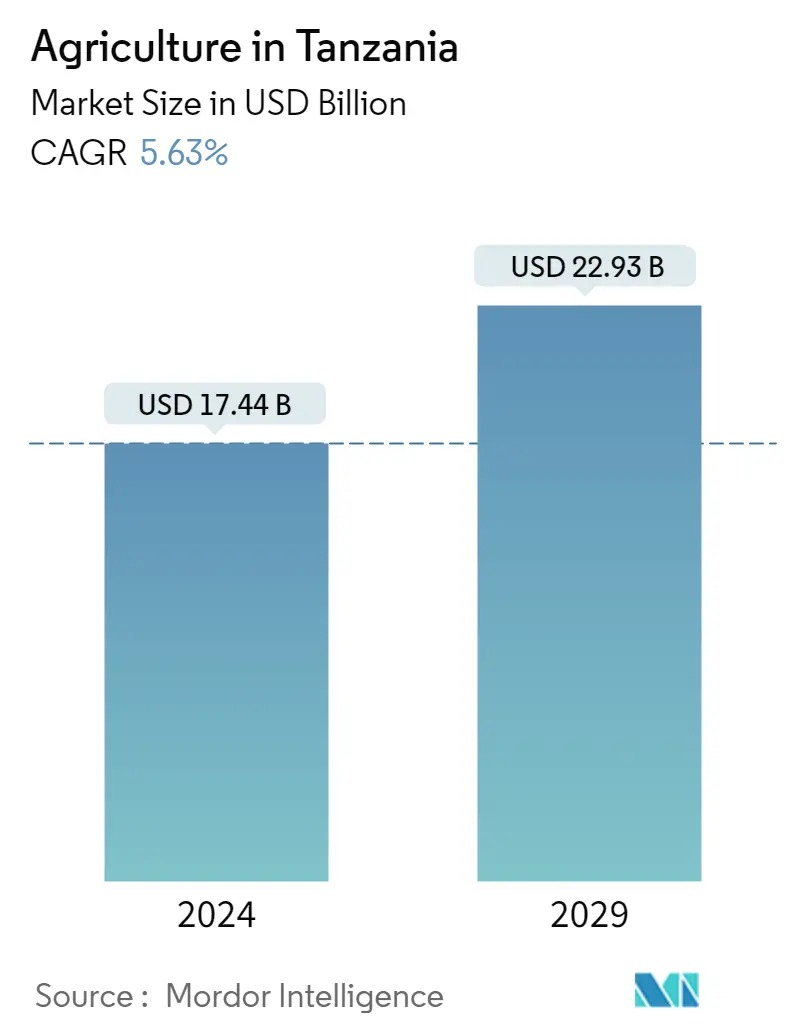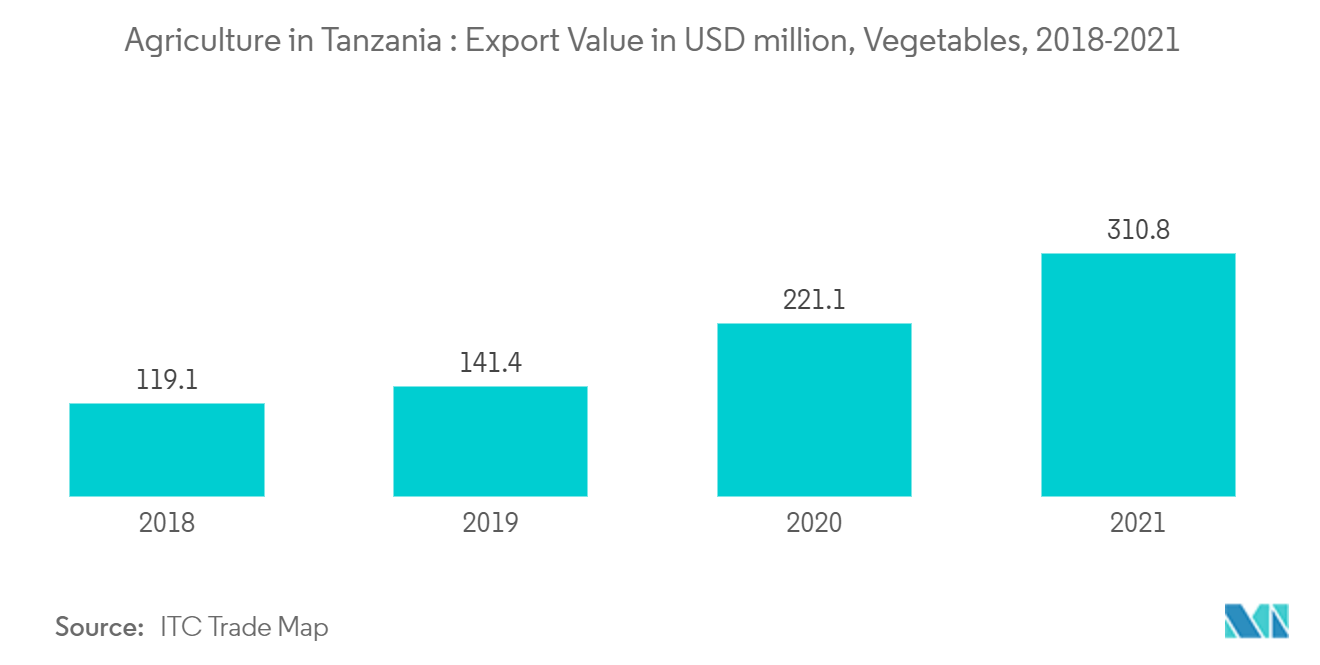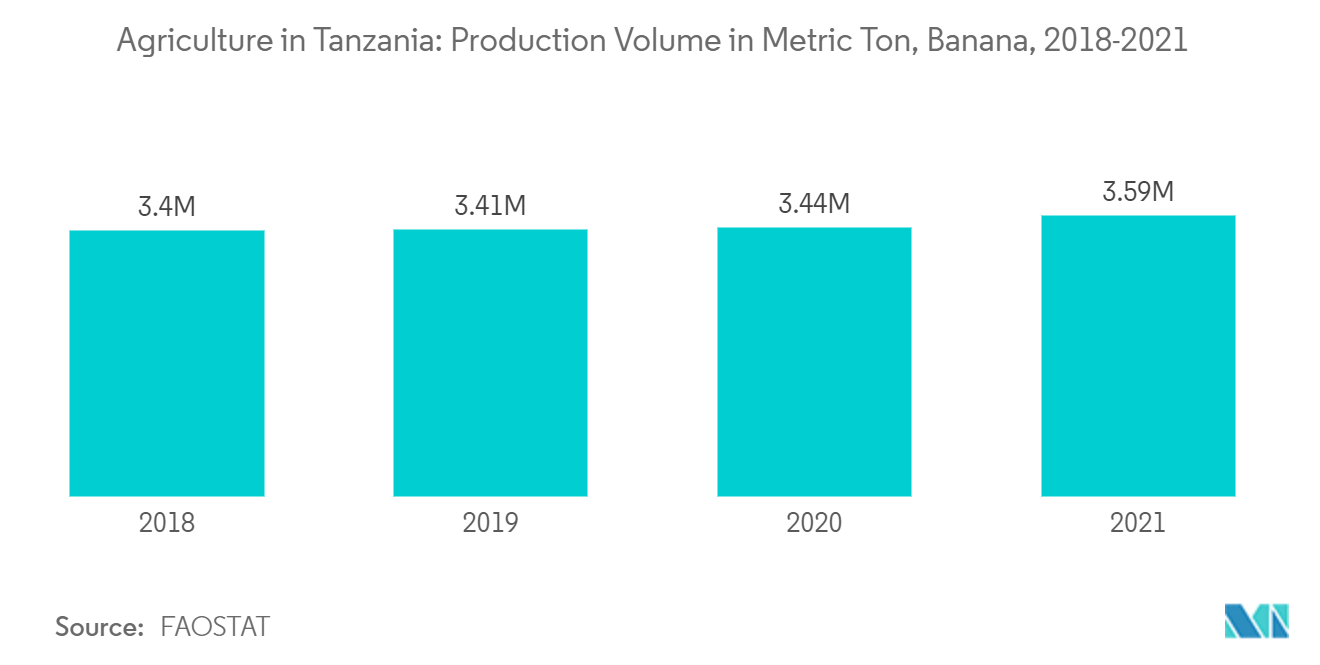Tanzania Agriculture Market Size

| Study Period | 2019 - 2029 |
| Base Year For Estimation | 2023 |
| Forecast Data Period | 2024 - 2029 |
| Market Size (2024) | USD 17.44 Billion |
| Market Size (2029) | USD 22.93 Billion |
| CAGR (2024 - 2029) | 5.63 % |
Tanzania Agriculture Market Analysis
The Agriculture in Tanzania Market size is estimated at USD 17.44 billion in 2024, and is expected to reach USD 22.93 billion by 2029, growing at a CAGR of 5.63% during the forecast period (2024-2029).
- Agriculture is the major backbone of the country's economy. Hence, structural measures are taken to boost agricultural production in the country with the support of public-private partnerships. Fruits hold a major share due to liberalization policies supporting their exports. Bananas, mangoes, oranges, pineapples, and watermelons are the major fruits produced in the country. Thus, private sector investments, favorable government policies, and trade agreements with neighboring countries will likely drive the market during the forecast period.
- Private sector investment in the agriculture sector, research activities conducted in collaboration with local institutions, and policy initiatives undertaken by the Tanzanian government to improve the business-enabling environment to promote agricultural growth will aid Tanzania's agricultural market development in the future.
- Tanzania is one of the largest cashew producers in Africa, with exports providing 10.0-15.0% of the country's foreign exchange. It mainly grows in the country's southern regions, such as Matwara and Lindi, and more than 90.0% of the nuts are exported in raw form. The raw nuts are mainly exported to India due to a very small domestic processing capacity. This factor is driving the agriculture market in the country.
Tanzania Agriculture Market Trends
This section covers the major market trends shaping the Tanzania Agriculture Market according to our research experts:
Favorable Government Policies Supporting the Market Growth
- Agriculture is the largest and most important sector of the Tanzanian economy, with the country benefitting from a diverse production base, including livestock, staple food crops, and cash crops. The government addresses specific issues by providing subsidies to farmers and investors and reducing needless levies impeding the sector's growth.
- The government also sought international funding for its flagship project, Tanzania's Southern Agricultural Growth Corridor (SAGCOT), which aims to exploit the region's agricultural potential swiftly. As a result of these broad initiatives, important crop production levels could increase in the future, boosting value-added processing in the industry. To increase regional investments, the government plans to incorporate private sector engagement, including the Southern Agricultural Growth Corridor of Tanzania initiative, a public-private partnership.
- The research activities, in collaboration with local institutions, help build the necessary capacity for long-term agricultural development. In 2020, the Ministry of Agriculture Tanzania and the World Vegetable Center (worldveg) signed a memorandum of understanding to improve R&D in vegetable crops and enhance nutrition and the country's food security. Thus, private sector investments and policy initiatives may boost the market's growth during the forecast period.

Increased Production of Banana is Driving the Market
- The country's fruit sector dominates the market, with popular fruits like bananas, mangoes, oranges, pineapples, and watermelons cultivated widely. The banana market in the country is developed due to exports and local demand by consumers.
- Tanzania and Uganda produce over 50% of all bananas on the African continent. Banana is part of the staple diet and one of the ten main food crops in the country. Most bananas (over 70%) are grown in Tanzania's Kagera, Kilimanjaro, and Mbeya regions. Morogoro, Kigoma, Mara, Arusha, Manyara, Ruvuma, Tanga, and Coast are other regions producing a significant amount of bananas.
- The global export value of the banana trade was estimated at USD 8.9 billion before the outbreak of COVID-19, with a retail value standing between USD 20 billion and USD 25 billion annually. The market is flourishing due to the increased consumer demand, and thus, organizations are putting efforts into producing new varieties.
- For instance, the Tanzania Agricultural Research Institute developed 16 new drought- and disease-resistant banana hybrid varieties in the three predominantly banana-producing regions of Mbeya, Kilimanjaro, and Kagera. Such factors may drive the demand for bananas in the country.

Tanzania Agriculture Market News
- September 2022: Tanzania's Ministry of Agriculture directed the Tanzania Agriculture Research Institute (TARI) to find a location for genetically engineered (GE) crop trials. This decision appeared to overturn the Tanzanian government's (GoT) 2021 ban on all GE crop research trials.
- July 2022: The African Development Bank Group has approved USD 73.5 million to increase food production in Tanzania by a million tonnes over three years.
- February 2022 : AgriFI, the EU-funded Agriculture Financing Initiative, and ElectrFI, the EU-funded Electrification Financing Initiative, hosted a signing ceremony and launch event on 16 February 2022 as part of the 7th edition of the EU-Africa Business Forum (EABF).
Tanzania Agriculture Market Report - Table of Contents
1. INTRODUCTION
1.1 Study Assumptions and Market Definition
1.2 Scope of the Study
2. RESEARCH METHODOLOGY
3. EXECUTIVE SUMMARY
4. MARKET DYNAMICS
4.1 Market Overview
4.2 Market Drivers
4.3 Market Restraints
5. MARKET SEGMENTATION
5.1 Crop Type(Production Analysis by Volume, Consumption Analysis by Volume and Value, Import Analysis by Volume and Value, Export Analysis by Volume and Value, and Price Trend Analysis)
5.1.1 Food Crops/Cereals
5.1.2 Fruits
5.1.3 Vegetables
6. REGIONAL ANALYSIS
6.1 PESTLE Analysis
6.2 Supply Chain Analysis
6.3 Government Policies
7. COMPETITIVE LANDSCAPE
7.1 Distribution Network and Retail Analysis
7.2 List of Distributors/Traders
8. MARKET OPPORTUNITIES AND FUTURE TRENDS
Tanzania Agriculture Industry Segmentation
Tanzania's agriculture sector accounts for nearly one-third of the country's GDP and employs 75% of the workforce-has the potential to raise incomes and improve livelihoods.
The Tanzania agriculture market is segmented by crop type (food crops/cereals, fruits, and vegetables). The report provides insight into production analysis (volume), consumption analysis (value and volume), export analysis (value and volume), import analysis (value and volume), and price trend analysis.
The report offers market estimation and forecast in value (USD million) and volume (metric ton) for the above-mentioned segments.
| Crop Type(Production Analysis by Volume, Consumption Analysis by Volume and Value, Import Analysis by Volume and Value, Export Analysis by Volume and Value, and Price Trend Analysis) | |
| Food Crops/Cereals | |
| Fruits | |
| Vegetables |
Tanzania Agriculture Market Research FAQs
How big is the Agriculture in Tanzania Market?
The Agriculture in Tanzania Market size is expected to reach USD 17.44 billion in 2024 and grow at a CAGR of 5.63% to reach USD 22.93 billion by 2029.
What is the current Agriculture in Tanzania Market size?
In 2024, the Agriculture in Tanzania Market size is expected to reach USD 17.44 billion.
What years does this Agriculture in Tanzania Market cover, and what was the market size in 2023?
In 2023, the Agriculture in Tanzania Market size was estimated at USD 16.51 billion. The report covers the Agriculture in Tanzania Market historical market size for years: 2019, 2020, 2021, 2022 and 2023. The report also forecasts the Agriculture in Tanzania Market size for years: 2024, 2025, 2026, 2027, 2028 and 2029.
Tanzania Agriculture Industry Report
Statistics for the 2024 Tanzania Agriculture market share, size and revenue growth rate, created by Mordor Intelligence™ Industry Reports. Tanzania Agriculture analysis includes a market forecast outlook to 2029 and historical overview. Get a sample of this industry analysis as a free report PDF download.



